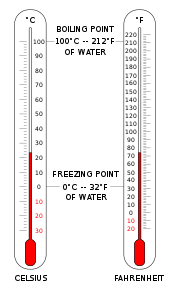The elements of climate.
Elements of climate: components of the atmosphere that can be measured. The main are:temperature, precipitation atmosheric pressure and wind.
Temperature and its factors.
Definition: temperature is the amount of heat in the air. It is measured in degrees Celsius (Cº), using a thermometer.
Temperature is determined by the following factors:
- Latitude. Between the Equator and the Tropics the temperature is always high because the rays of the Sun reach the Earth surface almost perpendicular, while in the Poles the solar rays reach the surface with an oblique angle.
- Altitude. The temperature drops 0.6ºC for every 100 metres above sea level, because the air is less dense and due to this conserves less heat.
- Distance from the sea. The sea waters change its temperature slower than the land, because of that temperatures are milder on the coast.Distance from the sea.
 |
| Madrid located 600 metres above sea leve. Medium average temperature in August is 26ºC. |
 |
| Navacerrada is a town, located near Madrid (50 km), but at an altitude of 1.200 metres above sea level. Medium average temperature in August is 16ºC. |
Also, we can distinguish different latitudinal thermal zones:
- One torrid zone, between the Equator and the Tropics.
- Two temperate zones, between the Tropics and the Polar Circles.
- Two frigid zones, around the Poles.
Isotherm: imaginary lines that connect locations with the same temperature in map.
Precipitation and its factors.
Precipitation: water that falls on the Earth's surface from the clouds, either in liquid (rain) or sold (snow and hail) forms.It is meassured with a pluviometer and it is calculated in milimetres (mm).
 |
| Pluviometer |
- Latitude. Precipitation levels are higher at the equator.
- Altitude and terrain. Precipitation levels rise in relation to increase of altitude.
- Distance from the sea. Precipitation levels are higher on the coast because the sea is a constant source of humidity.
 |
| Yakarta (Indonesia) located at a latitude of 4ºS has a precipitation level of about 1.800 mm, whereas Perth (Australia) located at a latitude of 31ºS has a precipitation level of 800 mm. |
 |
| As you can see in the image. The litoral zones of China recieve a far higher amount of precipitation than the interior zones. |



No hay comentarios:
Publicar un comentario